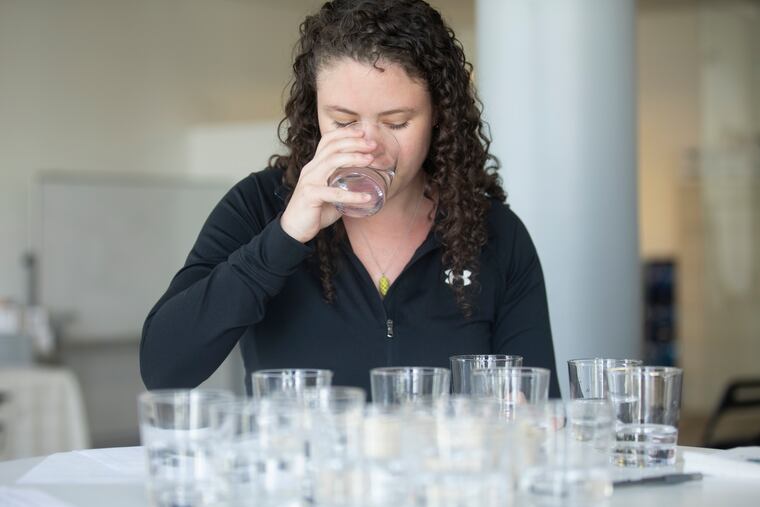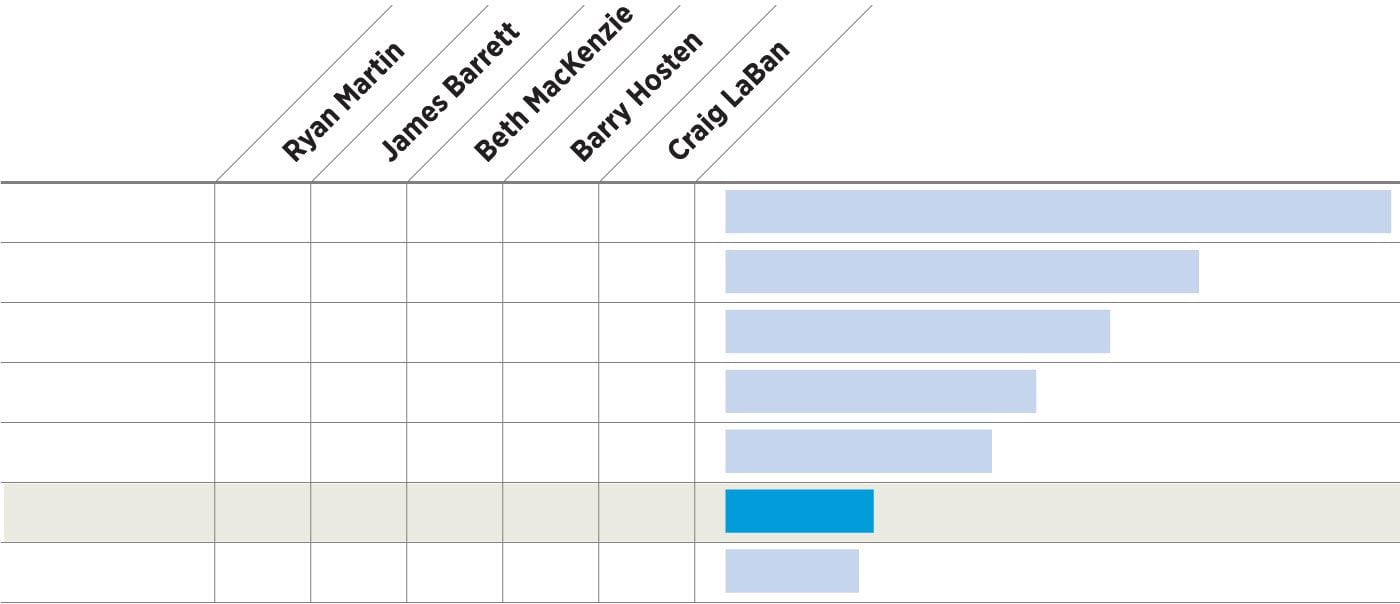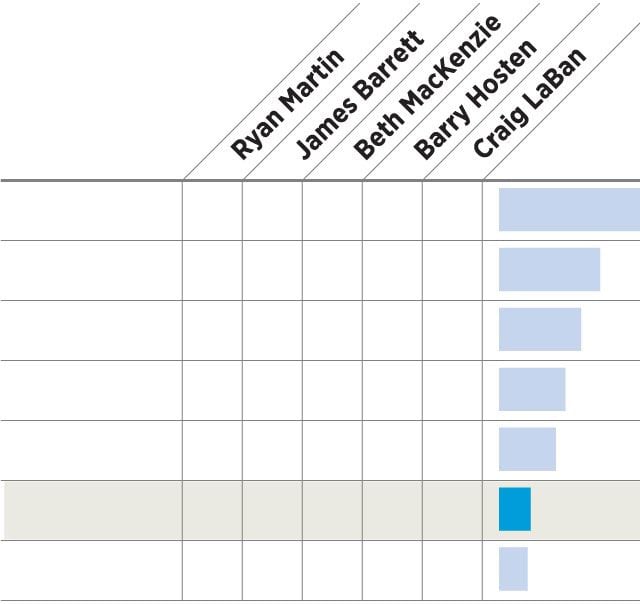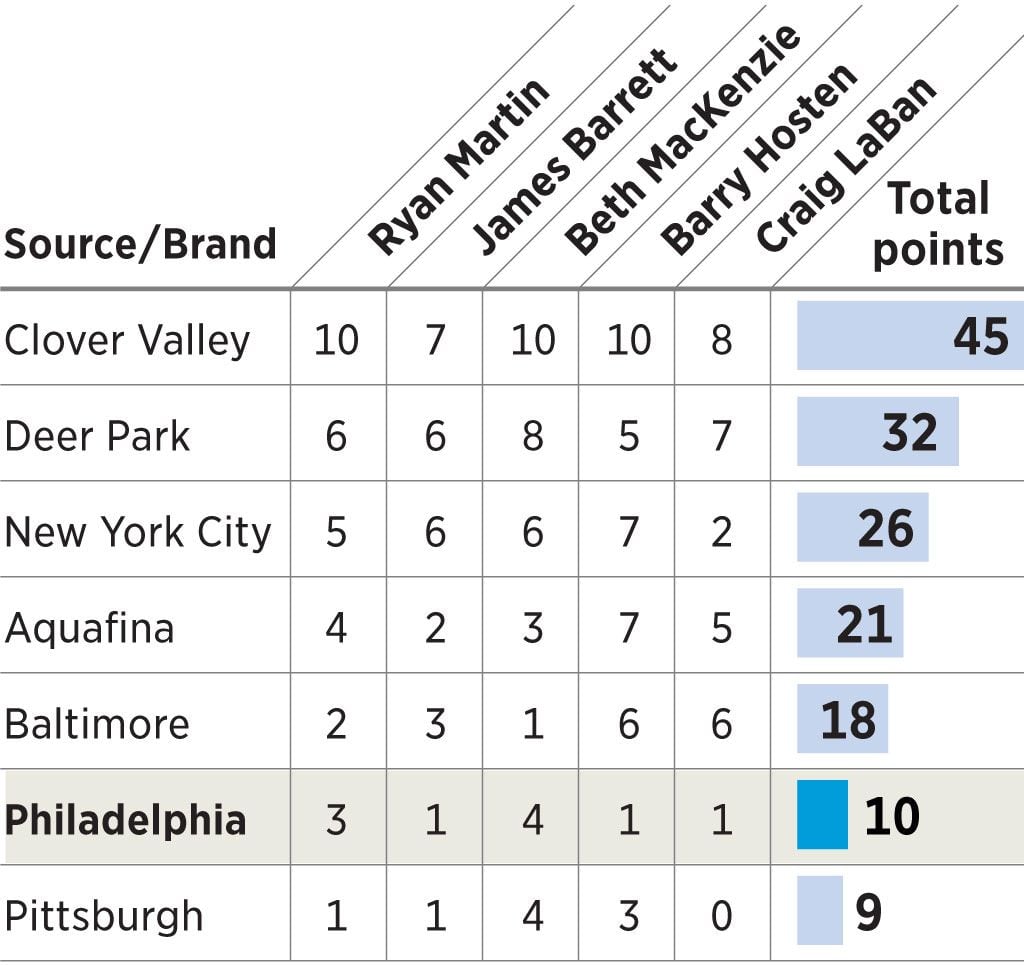How does Philly water stack up? A taste test by an expert panel reveals surprises.
Our volunteer panel of experts sniffed and swallowed seven water samples to see how Philadelphia's water stacked up against New York, Baltimore, Pittsburgh. and three brands of bottled water. How'd it do?

In silence, our volunteer panel sniffed and swallowed seven water samples, approaching the task with the ritualized reverence of a fine-wine tasting: A sip of Philadelphia tap water. A sip of New York, Baltimore, Pittsburgh. Sips of bottled Aquafina, Deer Park, and the cheapest dollar-store brand we could find.
In the end, the first-ever Inquirer water taste test’s top pick surprised us all. The rock-bottom water was a unanimous choice too. But in the middle, there were some wildly divergent views.
Before the big reveal, a little background:
The Philadelphia Water Department says nearly 40 percent of residents in customer surveys drink bottled water at home over tap because they believe there is either something wrong with the water or don’t think it tastes good — or both. It’s a black eye for the Water Department but costly for people who believe that they must shell out hard-earned money to buy in a bottle what they can get for pennies from the tap.
We spoke with residents. We visited the Water Department’s treatment plant and laboratory. We’ve been drinking from Inquirer spigots for years with no apparent ill effects. But we wanted more expert palates to weigh in.
Tasters and test
We picked a panel of people with a keen interest in water quality: Craig LaBan, The Inquirer’s food critic; Beth MacKenzie, water sommelier and certified brewmaster; James Barrett, owner of Metropolitan Bakery in Fishtown; Barry Hosten, brewery manager of Flying Fish Brewing Co. in Somerdale, Camden County; and Ryan Martin, an accountant at the African American Museum in Philadelphia and a city resident.
MacKenzie — the first water sommelier we’ve ever come across — studied her craft in Munich, Germany, consults for brewers, and is now working for a brewery in Belgium. LaBan sniffs out the best restaurants, food, and brews. Barrett and Hosten filter and check the pH balance of water they use for bread and beer — both of which depend heavily on high-quality water. Martin drinks bottled water at home, shunning the tap, despite the added cost.
At Rite Aid, we purchased Deer Park, which bills itself as “100 percent natural spring water” from Pennsylvania, Maryland, and South Carolina. At Dollar General, we purchased Aquafina, filtered and purified municipal tap water sold by PepsiCo., and Clover Valley, the store’s private brand and the cheapest bottled water per ounce of the three.
Before collecting municipal water samples, we (and volunteer collectors who had just been in New York, Baltimore, or Pittsburgh) allowed taps to run for several minutes to flush out any standing water. Samples were stored in clean, clear, unmarked glass bottles. We also poured the store-bought water into identical glass bottles. All seven bottles were refrigerated for two hours and removed 15 minutes before the taste test.
Panelists were served four ounces of each water in clear, clean glasses. All were numbered to disguise the source. Panelists were given a worksheet designed using Inquirer research and suggestions from MacKenzie.
After working their way silently through columns of the worksheet for appearance, aroma, mouthfeel, aftertaste, and overall taste, panelists rated each water on a scale of 1 to 10, with 10 being best. They then discussed their findings.
The verdict
“Most are similar,” MacKenzie said when panelists put down their pens. “Then there are two that are very distinctive."
Martin noticed that some water was good in some categories, but flopped in others.
“I can tell the difference right away between Number 1 and Number 7,” Martin said, to the agreement of most.
“You can tell some were filtered more than others,” Hosten observed.
LaBan said one reminded him of municipal pool water, which turned out not to be good news for those rooting for the local favorite. But LaBan, it should be noted, drinks Philly tap water at home — he just filters it and says that resolves the chlorine taste for him.
All the judges were surprised that the cheapest bottled water, Clover Valley — which none of the panelists had ever heard of — was the runaway winner. A 1.5-liter bottle cost $1.75, or 2.3 cents an ounce.
Alas, Philadelphia tap water did not fare well, coming in second from last, only a notch above the universally loathed Pittsburgh brew. Both cities draw their water from rivers — and both meet all federal health standards.
The Inquirer Water Taste Test
Five reviewers tasted three brands of bottled water (Clover Valley, Deer Park, and Aquafina) and municipal tap water from New York City, Baltimore, Philadelphia, and Pittsburgh. Philadelphia’s tap water ranked next to last, outscoring only Pittsburgh tap water.

Source/Brand
Total points
45
Clover Valley
10
7
10
10
8
32
Deer Park
6
6
8
5
7
26
New York City
5
6
6
7
2
21
Aquafina
4
2
3
7
5
18
Baltimore
2
3
1
6
6
10
Philadelphia
3
1
4
1
1
9
Pittsburgh
1
1
4
3
0

Total
points
Source/Brand
45
Clover Valley
10
7
10
10
8
32
Deer Park
6
6
8
5
7
26
New York City
5
6
6
7
2
21
Aquafina
4
2
3
7
5
18
Baltimore
2
3
1
6
6
10
Philadelphia
3
1
4
1
1
9
Pittsburgh
1
1
4
3
0

But there is no federal standard for water taste, though there are federal guidelines for chemicals that can lead to poor taste if exceeded.
And, for Philly, the distinct taste of chlorine was a major factor in its poor score, even though it falls within the guidelines. The sample was taken from a tap at The Inquirer’s Center City office after it ran for several minutes.
Philadelphia draws its water from an intake on the Delaware River and two on the Schuylkill. Because of The Inquirer’s location at Eighth and Market Streets, its sample could have come from either river.
The Philadelphia Water Department uses sodium hypochlorite, a form of chlorine similar to household bleach, as a disinfectant that’s approved by the U.S. Environmental Protection Agency. The department also adds another approved product, chloramine — chlorine combined with ammonia — as a secondary disinfectant. That’s for extra insurance against anything unpleasant that might develop as the water travels and sits in pipes before being tapped by the user.
All that safety was too much for LaBan. “Public pool level of chlorine,” he wrote on his score sheet. “Flashback to elementary school water cooler.”
Barrett detected a “sulphur” aroma and a “lingering” mouthfeel with a “bitter metallic” aftertaste in the Philly sample.
Martin also noted a metallic taste in her sample of Philadelphia water, describing it as if “a key fell in the cup.” Still, she rated Pittsburgh as the worst, writing, “terrible! immediate negative reaction,” before scoring it as a 1.
New York City tap fared much better among the panel, giving some credence to its age-old brag that it has the best municipal water in the nation. Our sample was taken from a residence in Manhattan’s Chelsea neighborhood.
It should be noted, however, that New York City gets half its water supply from a reservoir close to the source of the Delaware River in the Catskills. So, in a way, it’s the same as Philadelphia water.
But only in a way. Philly gets the water after it’s traveled more than 100 miles south in an open river, picking up pollution that has to be more extensively filtered or treated. New York’s water flows into the Big Apple via underground pipes.
Hosten described New York City water as clear and neutral, but also flat with a slight metallic taste. It tied with Aquafina for his second choice.
Of all the panelists, water sommelier MacKenzie gave Philadelphia water the highest score it would receive, a 4 overall. She gave Clover Valley water a 10.
Differences among the panelists suggest how subjective taste can be. For example, Hosten and LaBan gave Baltimore water slightly favorable scores, while others gave it decidedly low numbers.
Few had anything bad to say about Philadelphia water during a discussion after the panelists turned in their scores. Most reserved their scorn for Pittsburgh’s water.
So, in the end, we were surprised when we tallied up the score and saw that Philadelphia’s water had scored so low — beating its western rival by just one point. Kind of like the Phillies beating the Pirates in the ninth inning.
Editor’s Note: “From the Source: Stories of the Delaware River” is produced with support from the National Geographic Society, the Lenfest Institute for Journalism, and the William Penn Foundation. Editorial content is created independently of the project’s donors.
To support in-depth local journalism, click here to subscribe to The Inquirer.